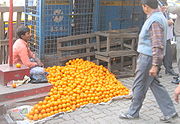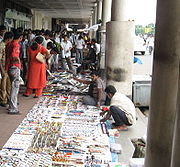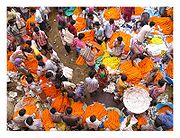
Hawkers in Kolkata
Encyclopedia




Crore
A crore is a unit in the Indian number system equal to ten million , or 100 lakhs. It is widely used in India, Bangladesh, Nepal, and Pakistan....
(around 2 billion U.S. dollars) in 2005. In Kolkata
Kolkata
Kolkata , formerly known as Calcutta, is the capital of the Indian state of West Bengal. Located on the east bank of the Hooghly River, it was the commercial capital of East India...
, formerly known as Calcutta, in the India
India
India , officially the Republic of India , is a country in South Asia. It is the seventh-largest country by geographical area, the second-most populous country with over 1.2 billion people, and the most populous democracy in the world...
n state
States and territories of India
India is a federal union of states comprising twenty-eight states and seven union territories. The states and territories are further subdivided into districts and so on.-List of states and territories:...
of West Bengal
West Bengal
West Bengal is a state in the eastern region of India and is the nation's fourth-most populous. It is also the seventh-most populous sub-national entity in the world, with over 91 million inhabitants. A major agricultural producer, West Bengal is the sixth-largest contributor to India's GDP...
, almost 80 per cent of the pavements are encroached by hawkers and illegal settlers.In many countries, hawkers
Hawker (trade)
A hawker is a vendor of merchandise that can be easily transported; the term is roughly synonymous with peddler or costermonger. In most places where the term is used, a hawker sells items or food that are native to the area...
use pavements or other public places to retail their goods or services but in Kolkata the magnitude has drawn special attention of administrators and law courts.
Background
The population of Kolkata urban agglomeration grew from 1,510,000 in 1901 to 4,670,000 in 1951 to 9,194,000 in 1981. Kolkata did not draw in people from rural areas by offering a better quality of life. As in any other Indian city, the immigrants found poverty in Kolkata as severe and dehumanising as in the villages, but was offered a relatively quick opportunity of new income through placement in the urban economy. With the partition of IndiaPartition of India
The Partition of India was the partition of British India on the basis of religious demographics that led to the creation of the sovereign states of the Dominion of Pakistan and the Union of India on 14 and 15...
in 1947, the metropolitan cities of Kolkata and Delhi
Delhi
Delhi , officially National Capital Territory of Delhi , is the largest metropolis by area and the second-largest by population in India, next to Mumbai. It is the eighth largest metropolis in the world by population with 16,753,265 inhabitants in the Territory at the 2011 Census...
were flooded by displaced persons or refugees from Pakistan
Pakistan
Pakistan , officially the Islamic Republic of Pakistan is a sovereign state in South Asia. It has a coastline along the Arabian Sea and the Gulf of Oman in the south and is bordered by Afghanistan and Iran in the west, India in the east and China in the far northeast. In the north, Tajikistan...
. The Union government
Government of India
The Government of India, officially known as the Union Government, and also known as the Central Government, was established by the Constitution of India, and is the governing authority of the union of 28 states and seven union territories, collectively called the Republic of India...
at Delhi, with better resources at its command, handled the task of rehabilitation faster and more comprehensively, than the state government
Government of West Bengal
The Government of West Bengal also known as the State Government of West Bengal, or locally as State Government, is the supreme governing authority of the Indian state of West Bengal and its 19 districts...
in Kolkata could accomplish. Left largely to themselves the refugees in Kolkata gradually secured their placements in the urban economy.
The 1951 census found that only 33.2 percent of Kolkata’s inhabitants were city-born, the rest were immigrants: 12.3 percent were from elsewhere in West Bengal, 26.6 percent from other Indian states, and 26.9 percent from East Pakistan. In 1981, the Government of West Bengal estimated the total number of persons displaced from East Bengal
East Bengal
East Bengal was the name used during two periods in the 20th century for a territory that roughly corresponded to the modern state of Bangladesh. Both instances involved a violent partition of Bengal....
to the state to be around 8 million or one sixth of the total population of the state. Several million refugees settled in the outskirts of Kolkata.
The percentage of migrants in Kolkata’s population has been declining since the 1950s, though around a third of the population still consists of fresh migrants. Kolkata is gradually attaining a state of saturation.It has also been affected by economic decline resulting from industrial sickness. In 2005, West Bengal headed the list of states with sick units.The overall economic scenario is highlighted by the growing number of pavement dwellers. Kolkata had 48,802 pavement dwellers in 1971 and 55,571 in 1985, according to Census and/or KMDA figures. Around two thirds are from West Bengal and the rest from outside the state.
While the economy of Kolkata has been sliding backwards in many respects, there has been remarkable expansion in certain areas – real estate
Real estate
In general use, esp. North American, 'real estate' is taken to mean "Property consisting of land and the buildings on it, along with its natural resources such as crops, minerals, or water; immovable property of this nature; an interest vested in this; an item of real property; buildings or...
, information technology
Information technology
Information technology is the acquisition, processing, storage and dissemination of vocal, pictorial, textual and numerical information by a microelectronics-based combination of computing and telecommunications...
and retail trade. Big shopping centres have come up, and along with it there has been a large increase in small shops and pavement stalls.
Political Actions
With hawkers occupying large portions of the pavements, in the sixties the state government, then controlled by the Congress Party
Indian National Congress
The Indian National Congress is one of the two major political parties in India, the other being the Bharatiya Janata Party. It is the largest and one of the oldest democratic political parties in the world. The party's modern liberal platform is largely considered center-left in the Indian...
, launched Operation Hawker and tried to remove hawkers from the streets of Kolkata. The Communist Party of India (Marxist)
Communist Party of India (Marxist)
The Communist Party of India is a political party in India. It has a strong presence in the states of Kerala, West Bengal and Tripura. As of 2011, CPI is leading the state government in Tripura. It leads the Left Front coalition of leftist parties in various states and the national parliament of...
, then in the opposition, organised the hawkers in active protest. Soon thereafter, the Congress Party was out of power in the state. Later, when the CPI(M) was firmly in saddle as leader of the Left Front
Left Front
The Left Front is an alliance of Indian leftist parties. After a 34-year reign in West Bengal, the Left Front was swept from power in the 2011 election...
for around two decades, it launched Operation Sunshine in 1996. Officers of Kolkata Municipal Corporation, cadres of the CPI(M) along with police battalions demolished the side walk stalls of thousands of hawkers. Such stalls had lined the city’s thoroughfares for nearly three decades. This time the hawkers were mobilised by opposition leaders such as Mamata Banerjee
Mamata Banerjee
Mamata Banerjee is the 11th and current chief minister of the Indian state of West Bengal. She is the first woman to hold the office. Banerjee founded All India Trinamool Congress in 1997 and became chairperson, after separating from the Indian National Congress...
but the Left Front remained firm in its conviction to remove hawkers.However, in the face of protests, the municipal administration and the police allowed the hawkers to reoccupy gradually the pavements of streets from which they had been cleared. The Calcutta Hawker Sangram Committee, a union of more than 32 local hawkers' associations formed in the beforemath of Operation Sunshine, took the leadership to reclaim the footpaths [Bandyopadhyay Ritajyoti (2009): Archiving from Below: The Case of the Mobilised Hawkers in Calcutta, Sociological Research Online, Volume 14, Issue 5,
Kolkata Police
The Kolkata Police Force is one of the two police forces of the Indian state of West Bengal....
, 80 per cent of Kolkata’s pavements are encroached by hawkers and illegal settlers. Pedestrians are forced to use the roads because there is hardly any space on the pavements for walking, and once people are getting used to walking on the streets, they continue to do so even if the side walks are vacant.Some reports suggest that the hawkers have made a comeback on the streets of Kolkata during the period 2000-2005 when Trinamool Congress
All India Trinamool Congress
The All India Trinamool Congress is a state political party in West Bengal. Founded in 1 January 1998, the party is led by Chief Minister Mamata Banerjee. Trinamool Congress is currently the second largest member of the ruling United Progressive Alliance coalition...
was in power in Kolkata Corporation.
Bandyopadhyay (2009)has recently argued that the Hawker Sangram Committee has subsequently come to occupy a central position in the governance of the realm of pavement-hawking through the creation and maintenance of an archival database that articulates the entrepreneurial capacity of the 'poor hawker' and his ability to deliver goods and services at low-cost. The significance of the Hawker Sangram Committee's archive is that, it enables the organisation to form a critique of the exclusionary discourses on the hawker, mostly propagated by a powerful combination of a few citizens' associations, the judiciary and the press. The paper also documents how the successful mobilisation of a population group like the hawkers is marked by the virtual destruction of a pre-existing archive on the other group of 'encroachers' of the pavement space, the pavement dwellers.
Legal action
With the politicians dilly-dallying, the matter rolled on to the courts as public interest litigation. In 1996, Kolkata High Court asked the state government to submit a detailed report on pavement encroachment. In 1998, another case demanding rehabilitation of hawkers was moved in the court. In 2003, the high court asked the state government to state its stand on hawkers. In 2005, the state government informed the high court that a uniform policy on rehabilitation of hawkers was underway. In 2007, the high court found that its 1996 order was not implemented.Commenting on a petition filed by environmentalist Subhas Dutta in 2004, the division bench of Chief Justice V.S. Sirpurkar and Soumitra Sen observed in 2006, that the hawker menace was growing like cancer. It was impossible for people to walk on the roads, forget about footpaths.
The advocate general informed the high court that the state government had drawn out a plan regarding the hawkers. The highlights of the plan were earmarking of hawker free zone, creating some hawking zones, setting time limits for hawking, banning erection of permanent structures, keeping two thirds of pavement free of hawkers, replacing polythene sheets with colourful umbrellas, removing of hawkers from 50 yards (45.7 m) of crossings, and issuing licences to existing hawkers only.
Municipal Corporation
KMC had conducted Operation Sunshine in 1996 to remove hawkers from Gariahat and Shyambazar. Following the hawker removal drive, the KMC commissioner, Asim Barman, had issued a notification imposing certain restrictions on the movement of hawkers on 21 streets in the city.Bikash Bhattacharya
Bikash Bhattacharya
Bikash Bhattacharya or Bikash Ranjan Bhattacharya is an Indian politician. He served as mayor of Kolkata 2005-2010, heading the Kolkata municipal corporation, in the state of West Bengal.-Short biography:...
, Mayor of Kolkata, has said that hawkers would be allowed to stay on all pavements across the city and they would be allowed to occupy a third of the pavements along the streets but they would not be allowed to occupy space within a 50-metre radius of road crossings or build any structures.
According to the Hawker Sangram Committee, “Hawkers are exploited by the agents of trade union leaders, politicians, police, civic councillors. They have to pay to earn their bread.” The hawkers pay 266 crores as bribe. This is around 3 per cent of the business. The Committee says, “We are willing to pay rent or some other form of tax to the civic body if we get the right to conduct business. Identity cards will protect us from extortion by multiple agencies,”
There are several unions or associations of hawkers, such as Calcutta Hawkers' Men Union
Calcutta Hawkers' Men Union
Calcutta Hawkers' Men Union is a trade union of hawkers in Kolkata. CHMU was founded in 1971. CHMU is affiliated to All India Trade Union Congress. Its membership is mainly based amongst food vendors.Source: ...
and Bengal Hawkers Association
Bengal Hawkers Association
The Bengal Hawkers Association is a trade union of hawkers in West Bengal, India. BHA is affiliated with the Trade Union Coordination Committee. BHA was founded in 1950, and is the oldest hawkers union in the state....
.

